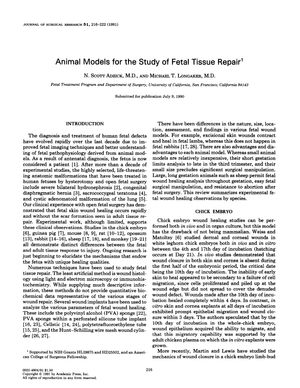Animal models for the study of fetal tissue repair
September 1991
in “
Journal of Surgical Research
”

TLDR Understanding how fetal wounds heal could help improve healing in adults.
The document from 1991 reviews animal models used to study the unique characteristics of fetal tissue repair, particularly the rapid and scarless healing observed in fetal wounds. The authors, N. Scott Adzick and Michael T. Longaker, discuss experimental findings from chick embryos, guinea pigs, mice, rats, opossums, and rabbits, using techniques such as wound histology and immunohistochemistry. They note that fetal wounds exhibit rapid collagen deposition and high levels of hyaluronic acid, which differ from adult wound healing processes. The review also mentions that not all fetal tissues heal without scarring, as seen in diaphragmatic wounds in fetal lambs. The document concludes that understanding fetal wound healing mechanisms could inform strategies to improve adult wound healing.